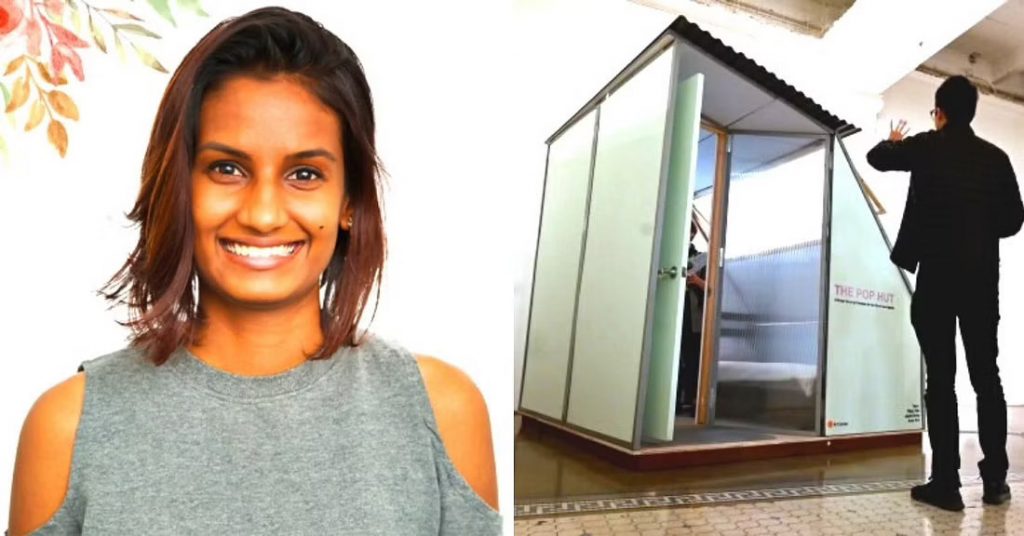26-Year-Old Indian-Origin Designer’s Foldable Homes Could Be the Answer to Homelessness
Jayati Sinha, a San Francisco-based designer, has come up with a potential solution called Pop Hut, an easily transportable, foldable and flat packed housing concept.

Image Credits: The Better India
Jayati Sinha, a San Francisco-based designer, has come up with a potential solution called Pop Hut, an easily transportable, foldable and flat packed housing concept.
It was in April 2018, when, Eric Garcetti, the Mayor of Los Angeles, reached out to a number of architecture and design schools for guidance in designing bridge housing (a temporary shelter) for homeless people, that Jayati Sinha came up with the idea of Pop Hut. Jayati Sinha was at the time doing her Masters in environmental design at ArtCenter College of Design in Pasadena, under Professor James Meraz.
She wanted to build a solution for homeless people. There are an estimated 1.8 million homeless people in India, with 52% based in urban areas. A further 73 million families lack access to decent housing (IGH, 2018; Habitat, 2019). This number is far more serious than the estimated 5,53,742 people in the United States experiencing homelessness on a given night.
So Jayati and her fellow team members came up with Pop Hut, an easily transportable, foldable and flat packed housing concept featuring a shaded entry, which is intended to give the structure a cosier feeling of coming home.
“The Pop Hut has a front door with a keyed lock and a tiny front stoop completed with a motion-activated porch light. Inside the hut, we used colour and transparency as therapeutic tools to make users feel secure and cared for. The interiors also had some open shelving so that the user can customise it with their personal aesthetic and belongings to make it feel like home and for the users to regain a sense of belongingness and foster love for the community The total footprint of the Pop Hut is 5 square meters. So, this is an ideal solution for temporary housing to be provided at construction sites, defence installations and even for slum dwellers. Pop Hut was built for about $2,000 (about ₹1.5 lakh) which could be made even cheaper if made in bulk and using lower-cost materials in India,” Jayati explains.
Being a temporary housing solution, the design focuses on:
- Being flat pack for mobility and ease in deployment
- Corrugated sheets in the structure to give it strength without making it heavy
- Natural ventilation and light
- Slanted roof to give more room for solar panels and protect the roof from retaining water
- Open wall shelves for users to personalise their house
At this moment this hut prototype is made up of birch plywood, polycarbonate panels (translucent material), aluminium tubes for frames and honeycomb panels for insulation.
“However, those materials are not the highlight of this concept and can be defined further, depending on need,” she says adding, “What makes this concept great is the flat-packed design that can be reassembled, expanded and contracted into different sizes because of the panel design. See, materials can be interchanged with locally available ones that are more relevant to the location they are being set up in. I would classify materials as sustainable rather than eco-friendly. If you look at the line diagrams below you will also notice that the house does not lay flat on the ground but has feet that keep it above the ground which can be very helpful in places where water can get trapped due to heavy rainfall. The aluminium frames give it a sturdy structure for it to stand heavy weather conditions.”
These Pop Huts can easily be deployed and moved to different locations to create a safe environment for temporary workers, victims of flood and other disaster relief projects, armed forces, refugee camps, and poor people, claims Jayati.
Nonetheless, at no point is it being claimed that these shelters will solve homelessness. After all, this is temporary housing. Structures like the Pop Hut are not a one-stop solution to the problem of homelessness. Governments need to first understand people living in homelessness to determine their needs and thus a comprehensive survey is required in all major cities first.
“But my hope is to inspire people in India to bring change through this emergency temporary housing initiative,” Jayati concludes.
Credits: The Better India
Read the full story here.








